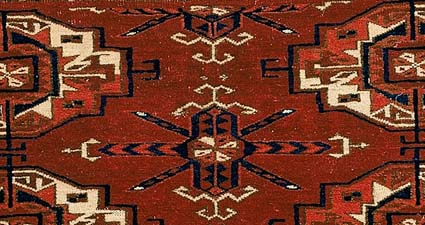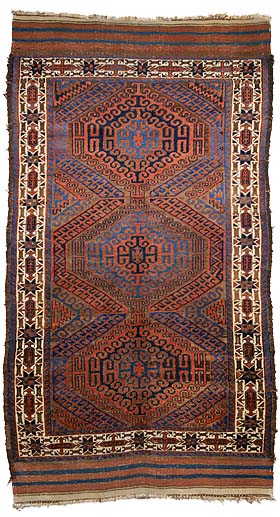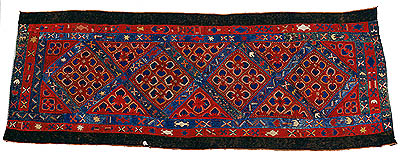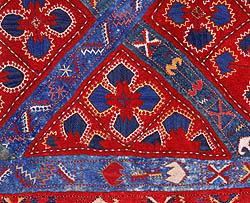|
The following section focuses on the key elements of Central
Asian textile arts.
Motifs
Motifs are the distinctive figures featured in many art
forms. The motifs in Central Asian textiles are often abstract.
Abstracting motifs was essential because of the technological
limitations and constraints of flat weaving, ikat
and felts. Knotted pile carpets and embroidery allow greater
design freedom. Another reason for the wide use of abstract
motifs was that Islamic religion forbids the use of realistic
images, hence the images became highly stylised motifs.
The
ram's horn is a common and very ancient motif. Note the
ram's horns in Fig. 4. Floral motifs and patterns occur
in both nomadic and urban textiles, both naturalistic (suzani)
and stylised (rugs and ikats). Animal motifs are
common in nomadic rugs, as the nomads are still influenced
by shamanistic beliefs and not as heavily influenced by
Islam.

Fig.
4 Detail of Tekke Turkmen carpet.
Wool warp, wool and cotton weft float brocade, made
by Tekke Turkmen women in western Turkestan, late 1800s.
3120 x 1850 mm. 85/1900. Powerhouse Museum Collection. |
Repeating
motifs
Central Asian textiles, such as nomadic rugs and carpets
and urban ikats, are characterised by the use of
repeating motifs. The reasons for this are:
- repeating
motifs are easier to memorise
- ikats
entail repeats.
The
patterns formed by the repetition of motifs were memorised
by women and passed down from generation to generation.
It was easier to memorise a discrete motif and repeating
pattern than a free-flowing design. Rugs can usually be
attributed to a particular cultural group by the motifs
used.
Young
girls learn the skills of textile production from an
early age, under the supervision of an older woman,
and the designs used by their particular tribal group
are committed to memory over many years of training
and practice. By their early twenties, most young Turkmen
women are skilled weavers and those who have not yet
had children may expect to spend up to 12 hours a day
weaving. (Sumner, 1999:28).
Activity
Compare the motifs in the following two rugs. (Figures 5
and 6)
|

Fig.
5 Baluchi prayer rug
The weaver, a nomadic Baluchi woman, has used brilliantly
coloured silks for the 'trunks' of the tree motifs
in the central mihrab (prayer niche) and corner spandrels
of this rug. The influence of Turkmen design is evident
in the guls of the wide border surrounding the mihrab.
Wool warp and weft, wool and silk, asymmetrical knots,
made in north-western Afghanistan, about 1900. 1520
x 1030 mm. 96/39/1, Powerhouse Museum Collection,
purchased with the assistance of the Oriental Rug
Society of NSW, 1996.
|

Fig. 6 Mushwani Baluchi rug
Wool, symmetrical knots, made by Mushwani Baluchi
women in western Afghanistan, about 1900. 1880 x 1020.
Powerhouse Museum Collection. A8358.
|
The
colours used in nomadic textiles — browns, rich dark
red and blues — were darker and earthier than those
used by the oasis dwellers. Silk was available in the towns
and cities and lighter colours were often chosen. Silk was
a highly valued fibre.
Activity
Look at the detail in Fig. 5 Baluchi prayer rug. Note the
coloured silks used in the trunk of the tree of life.
Rugs
Three types of rugs are produced in Central Asia:
- knotted
pile
- flat-weave
- felt.
Rugs
and carpets are made in a nomadic context and also
in villages and towns. Village rugs are made by women
who were once nomadic, using the same or similar patterns.
These rugs are often larger and made for the market
place. Urban rugs were made by men in workshops on
fixed looms. The use of cartoons was necessary for
more complex patterns. Cartoons are drawings of the
same size as a planned pattern for a rug. It is used
as a model so the pattern can be transferred or copied.
See Fig. 7.
In
addition to making textiles for their family's own
needs, nomadic women produced rugs for sale to town
and village people, many of whom were once nomadic
themselves and wanted nomadic rugs for their permanent
homes.
The
shape, method of weaving, dyes, patterns, knot density,
and designs of a weaving all tell something about
the life of the weaver as well as its use. It tells
if she was nomadic or settled, which tribe she was
from, and the weaving's intended use. (O'Bannon,
1998: 11)
|
 Fig.
7 Rug design from Iran
Fig.
7 Rug design from Iran
Paper, pencil and watercolour, painted in Iran, about
1920.
540 x 373 mm.
Powerhouse Museum collection 86/1715 |
Rugs
can be attributed to particular cultural groups and even
tribes within a culture by analysing the following characteristics:
- Type
of knot
- Type
of motif, in particular, type of gul
- Colours
- Warp
colour
- Weft
colour and fibre
- Edge
finish, for example, selvedge or overcast
- Knots
per square unit
- Fringe.
(O'Bannon, 1998: 25)
Felt
rugs
Central Asian felts are made by:
- placing
wool fibres in layers on a reed mat
- applying
heat and water
- compressing
the fibres by rolling up the mat then continuing to roll
the mat back and forth.
The
natural properties of wool allow it to felt quite easily.
Except
for yurt coverings, which are mostly white, felts are
generally patterned by several different methods:
Layering
This method can result in a felt with the pattern on one
or both faces of the felt. For one face, wool of a single
colour is laid on a reed mat in the size desired. Wools
of other colours are placed on top of the foundation wool
in the pattern desired. The resulting felt shows only
the foundation wool on one side and the pattern on the
other. For two faces, the variously coloured wools are
placed directly on the reed mat in the pattern desired.
The resulting felt shows the pattern on both sides. A
variation is to lay a coarse rope of wet, dyed wool on
top of the patterned area to create a secondary pattern.
When rolled in the felting process, the dye in the rope
transfers to the felt. After felting, this rope is removed,
leaving the pattern.
Mosaic
In this method, felts of different colours are cut into
pieces and sewn together to create simple or intricate
patterns. For some of the most complex patterns, two or
more large felts are made in different primary colours.
These felts are then stacked on top of one another and
cut into pieces, cookie-cutter style. If three colours
are used, the coloured pieces are reassembled and sewn
together, jigsaw fashion, into three felts of three colours.
Applique
In this method, pieces of felt or other fabrics are sewn
onto a finished felt to create a pattern.
Embroidery
In this method a felt in any technique will have an additional
pattern applied by embroidery. (O'Bannon, 1998: 16)

Fig.
8 Lakai Uzbek felt rug
Pieced and embroidered felt rug made by nomadic Lakai
Uzbek women in Southern Uzbekistan in the 1920s. Powerhouse
Museum Collection. |

Fig.
9 Lakai Uzbek felt rug detail
Detail: the embroidery stitches used to decorate the
Lakai Uzbek felt rug are similar to those used by urban
Uzbek women to embroider their suzanis. The filling
stitch is called basma, and is a form of couching.
|

Fig.
10 Lakai Uzbek felt rug detail
Detail: the back of the Lakai Uzbek felt rug, showing
how shaped pieces of red and blue felt are joined together
to form the whole. |
Activity
Find out how to make felt. Make a 20 cm x 20 cm sample of
a felt rug. You may like to dye the fibres using natural
dyes. Look carefully at the detailed photos of the Lakai
Uzbek felt rug, Figures 9 and 10. Design a pattern for your
sample reflecting Central Asian culture. Select and apply
suitable fabric decoration, perhaps embroidery, to enhance
the design.
|